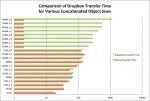I’ve been a storage revolutionary for quite a while, looking for new ways of data storage rather than technologies that perpetuate the same old approaches. That’s why I’m excited about the implications of two very different API access methods announced by Dropbox at DBX and by Fusion-io today at OSCON.
Dropbox
What’s (Still) Wrong With Dropbox For Business
I am a heavy (and paying) user of Dropbox, using it both for business and personal storage and synchronization. Although I find the service incredibly useful, Dropbox is far from perfect, especially for business users. So I thought I would take a few moments to talk about what I’d like to see Dropbox improve.
Geoff Barrall is Back with Transporter, a Personal Shared Storage Solution
I’m a hardcore Dropbox user, but I don’t love their limited sharing features or having my personal data in the cloud. I was intrigued by the waves of personal shared storage devices that have appeared, but none are appropriate and complete replacements for Dropbox. But a new product just launched on Kickstarter really has a chance of success!
Is SolidFire out in Left Field, or Are They Playing a Whole New Ballgame?
When I say “cloud storageâ€, you probably think of Amazon S3: Big, slow, cheap, and distributed. That’s probably why the people I talk to about SolidFire usually start shaking their heads and denouncing the company. After all, who would be crazy enough to create an all flash storage array for cloud storage applications? But maybe it’s not so crazy; maybe SolidFire is simply playing a different ballgame.
How Does Dropbox Store Data?
Dropbox recently clarified (via their blog and privacy policy) that they “de-duplicate” user files. This has been known for quite a while, and is obvious to anyone who’s had a large file “upload” instantly. But how exactly does Dropbox store files? Are they really de-duplicated or just single-instanced? I set out to discover the answer.




